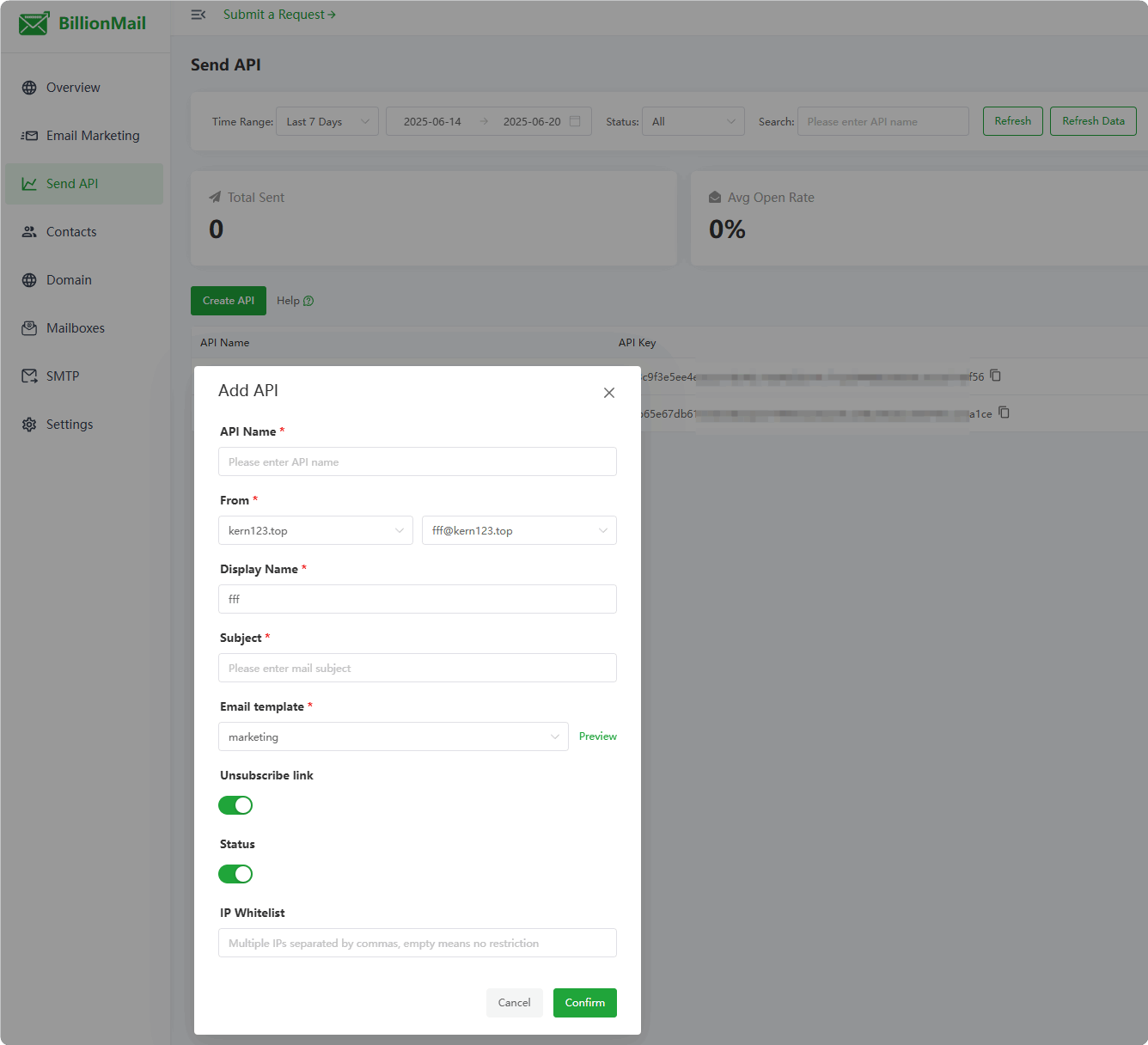BillionMail API Email Sending Function Guide
Function Overview
BillionMail API's email sending function provides a complete email delivery solution, supporting the following core features:
✉️ Template-based email sending
👤 Customizable sender
📊 Comprehensive data tracking (Opened rate/Clicked rate/Bounced rate)
🔄 Unsubscription management
📈 Detailed sending statistics
API Key Management
Create an API Key
Sending API --> Create API
Click "Create API" and fill in relevant information (API name, email template, sender, subject, IP whitelist, etc.). The system will automatically generate a unique API Key.
- Supports independent IP whitelist configuration for each API to enhance security

Email Sending API
Send a Single Email
Request Information:
Endpoint:
/api/batch_mail/api/sendMethod:
POSTAuthentication: Required
Request Headers:
X-API-Key: YOUR_API_KEY
Content-Type: application/jsonRequest Body:
{
"recipient": "[email protected]",
"addresser": "[email protected]",
"attribs": {
"username": "Jesse",
"order_id": "20240501"
}
}Request Parameter Description:
| Parameter | Type | Required | Description |
|---|---|---|---|
| recipient | string | Yes | Recipient's email address |
| addresser | string | No | Custom sender's email address |
| attribs | map[string]string | No | Custom attributes for template variable replacement |
Note: If the
addresserparameter is not passed, the default sender email will be used.The
attribsfield can be used for personalization of email template variables. In the email template, use
{{.API.attribute name}}For example
{{.API.username}}
{{.API.order_id}}Response Example:
{
"success": true,
"code": 0,
"msg": "Email sent successfully",
"data": null
}Usage Examples
CURL Example
# Send an email
curl -k -X POST 'https://your-domain.com/api/batch_mail/api/send' \
-H 'X-API-Key: YOUR_API_KEY' \
-H 'Content-Type: application/json' \
-d '{
"recipient": "[email protected]",
"attribs": {
"username": "Jesse",
"order_id": "20240501"
}
}'Python Example
import requests
def send_email(api_key, recipient, attribs):
url = 'https://your-domain.com/api/batch_mail/api/send'
headers = {
'X-API-Key': api_key
}
data = {
'recipient': recipient,
'attribs': attribs
}
response = requests.post(url, headers=headers, json=data)
return response.json()Batch Sending API
Endpoint Information:
- Endpoint:
/api/batch_mail/api/batch_send - Method:
POST - Authentication: Required
Request Headers:
X-API-Key: YOUR_API_KEY
Content-Type: application/jsonRequest Body Example:
{
"recipients": [
"[email protected]",
"[email protected]"
],
"addresser": "[email protected]",
"attribs": {
"promo_code": "VIP2024",
"username": "Dear User"
}
}Parameter Description:
| Parameter | Type | Required | Description |
|---|---|---|---|
| recipients | string[] | Yes | Array of recipient email addresses |
| addresser | string | No | Custom sender email address |
| attribs | map[string]string | No | Custom attributes, shared by all recipients |
Note: For batch sending, variables in
attribswill be applied to template rendering for all recipients.
Response Example:
{
"success": true,
"code": 0,
"msg": "Batch email send request accepted, 2 emails queued",
"data": null
}Template Variable Personalization Instructions
- For batch sending, all recipients share the same set of
attribs. - For single sending, different
attribscan be passed for each recipient individually. - The email template can use the following variables, whose values are passed by
attribs.
{{.API.username}}
{{.API.promo_code}}Usage Examples
Batch Sending CURL Example
curl -X POST 'https://your-domain.com/api/batch_mail/api/batch_send' \
-H 'X-API-Key: YOUR_API_KEY' \
-H 'Content-Type: application/json' \
-d '{
"recipients": ["[email protected]", "[email protected]"],
"addresser": "[email protected]",
"attribs": {
"promo_code": "VIP2024",
"username": "Dear User"
}
}'Batch Sending Python Example
import requests
def batch_send_email(api_key, recipients, attribs):
url = 'https://your-domain.com/api/batch_mail/api/batch_send'
headers = {
'X-API-Key': api_key
}
data = {
'recipients': recipients,
'attribs': attribs
}
response = requests.post(url, headers=headers, json=data)
return response.json()Error Code Explanation
| Error Code | Description | Solution |
|---|---|---|
| 1001 | Invalid API key | Check if the API key is correct |
| 1002 | IP not allowed | Check if the IP whitelist is set |
| 1003 | Invalid recipient | Check the email address format |
| 1004 | Template does not exist | Check the template ID |
| 1005 | Sending failed | View detailed error logs |
Feature Descriptions
IP Whitelist Function
Each API can be individually configured with an IP whitelist, allowing only specified IPs to call the API.
If no whitelist is set, all IPs can access the API.
Whitelists can be configured during API creation and updates, and can be adjusted at any time later.
Calls from non-whitelist IPs will return error code 1002.
Email Tracking Function
Open Tracking
Automatically records the number of email opens
Counts the number of unique open users
Provides data on open time distribution
Link Tracking
Tracks clicks on links in emails
Records clicking users and times
Analyzes link click popularity
Data Statistics
Updates statistical data in real-time
Provides multi-dimensional analysis
Unsubscription Management (Optional)
Unsubscription Link
Automatically adds an unsubscription link at the bottom of emails
Supports one-click unsubscription
Automatically updates unsubscription status
Unsubscription List Management
- Maintains a global unsubscription list
Sending Statistics
Provides statistical data in the following dimensions:
Total number of sent emails
Delivery rate
Open rate
Click-through rate
Bounce rate
Unsubscription rate
Best Practices
Security Recommendations
API Key Management
Properly store API keys
Regularly replace API keys
Avoid key leakage
Access Control
Use HTTPS for API calls
Set up IP whitelists
Monitor abnormal access
Sending Optimization
Sending Strategy
Reasonably control sending frequency
Avoid intensive sending
Pay attention to sending statistics
Address Management
Regularly clean up invalid addresses
Promptly handle bounced emails
Maintain a blacklist
Content Optimization
Template Management
Use variables to achieve personalization
Keep templates concise
Update content regularly
Performance Optimization
Conduct A/B testing
Analyze statistical data
Optimize sending time
FAQs
1. Sending Issues
Q: How to handle emails that failed to send?
A: The system automatically records failed emails. You can view the reasons for failure through the API management list in the dashboard.
2. Statistical Issues
Q: How to improve the delivery rate?
A: Maintain a good sending record, avoid sending spam, and regularly clean up invalid addresses.
3. Functional Issues
Q: How to view sending statistics?
A: You can do so through the API list in the dashboard.
4. Technical Issues
Q: Does it support batch sending?
A: Currently, the API only supports sending single emails. For batch sending, please use the task function.
5. Other Issues
Q: How to handle unsubscription requests?
A: The system automatically processes unsubscription requests and maintains the unsubscription list.
